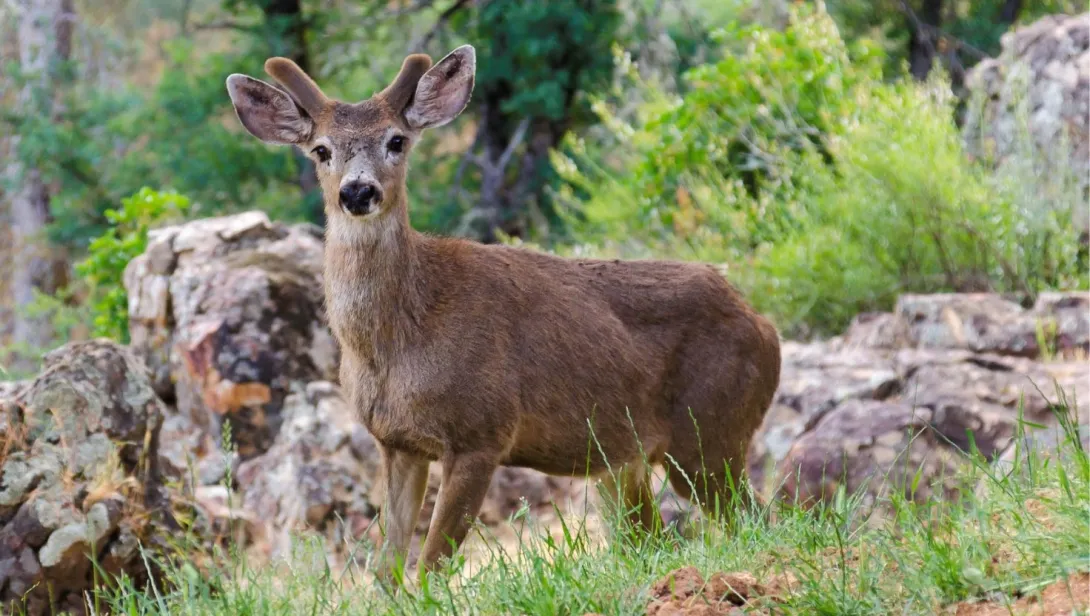Skip to main content
General Information
- The Mule Deer (Odocoileus hemionus) is a species of deer native to North America.
- It is named for its large ears, which resemble those of a mule.
- Mule deer are found in western North America, including the U.S., Canada, and Mexico.
- They are herbivores, primarily feeding on leaves, shrubs, and grasses.
- Mule deer are well known for their unique bounding gait, called "stotting," where they leap with all four legs.
Physical Characteristics
- Males, known as bucks, can weigh between 55 to 150 kg (120 to 330 lbs).
- Females, called does, are smaller, weighing around 43 to 90 kg (95 to 200 lbs).
- Their height at the shoulder ranges from 80 to 105 cm (31 to 41 inches).
- Mule deer have a grayish-brown coat in winter and a reddish-brown coat in summer.
- They have a distinctive white rump patch with a black-tipped tail.
- Bucks grow large, forked antlers that they shed and regrow annually.
Habitat and Adaptation
- Mule deer live in a variety of habitats, including mountains, forests, deserts, and grasslands.
- They are highly adaptable and can survive in harsh climates.
- They migrate seasonally, moving to higher elevations in summer and lower valleys in winter.
- Mule deer have excellent vision and can detect movement from long distances.
- They rely on their keen sense of smell and hearing to detect predators.
Diet and Feeding Behavior
- Mule deer are herbivores and eat leaves, twigs, shrubs, berries, and grasses.
- They are selective feeders, preferring nutrient-rich plants over low-quality forage.
- They feed mostly during dawn and dusk to avoid predators.
- Mule deer have a complex, multi-chambered stomach to digest fibrous plant material efficiently.
Social Behavior
- Mule deer are social animals and typically live in small herds.
- Females and their young form groups, while males often live alone or in bachelor groups.
- During the mating season, bucks become territorial and compete for females.
- They communicate through body language, vocalizations, and scent markings.
Reproduction and Lifespan
- The breeding season (rut) occurs in late fall, usually from October to December.
- Bucks compete for does by engaging in antler fights.
- After a gestation period of about 200 days, does give birth to one or two fawns in late spring or early summer.
- Fawns are born with white spots for camouflage and stay hidden for the first few weeks.
- Mule deer have an average lifespan of 9-11 years in the wild but can live longer in captivity.
Threats and Conservation
- Mule deer populations are threatened by habitat loss, vehicle collisions, hunting, and climate change.
- Predators such as mountain lions, wolves, and coyotes prey on mule deer.
- Human development and wildfires are reducing their natural habitat.
- Many conservation programs focus on habitat preservation, hunting regulations, and wildlife corridors.
- Mule deer are a popular game species, and hunting is managed to maintain healthy populations.
Interesting Facts
- Mule deer do not run like other deer; instead, they bound in a unique four-legged leap called "stotting."
- They have a wide field of vision due to the placement of their eyes.
- Mule deer can jump over fences up to 2.5 meters (8 feet) high.
- Unlike some deer species, mule deer do not form large migratory herds.
- They are crepuscular, meaning they are most active during early morning and late evening.
